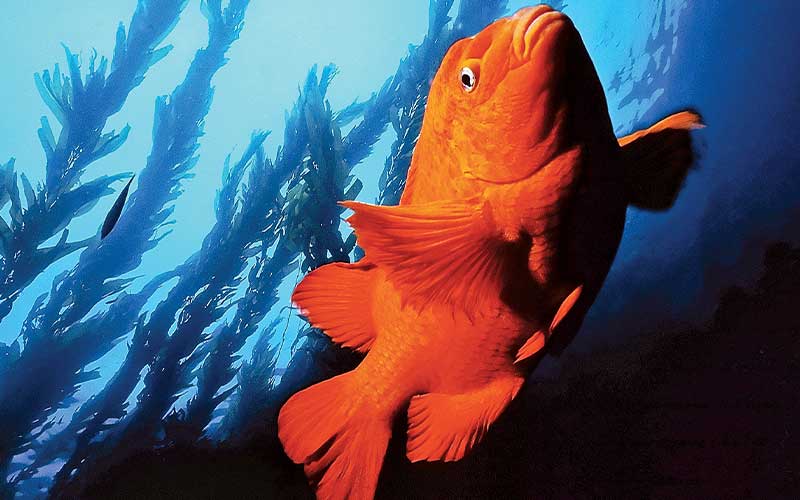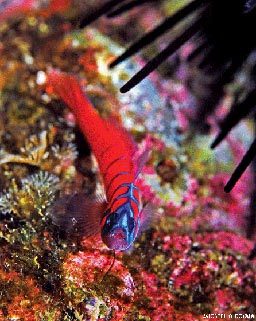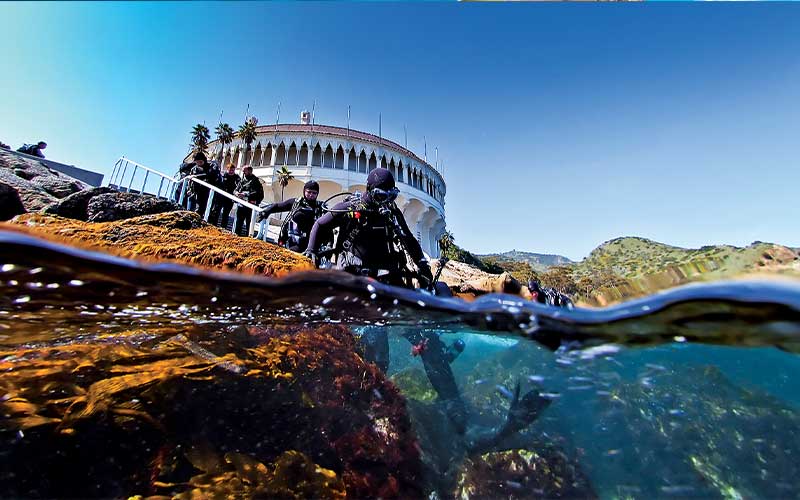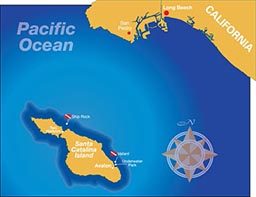Hoo-nahr had finally dipped his oar for the last stroke of a long and tiring journey. Even under the best circumstances, paddling a dugout canoe some 28 miles across cold Pacific waters was a challenge. Hoo-nahr’s canoe, along with those of the others who made the crossing, was filled with trade goods. Hides, salted meat, construction materials and more would be exchanged with the island’s residents for seafood, abalone shells and other goods.
As was the custom once business was concluded, Hoo-nahr and his Chumash colleagues were invited to a big feast before they left the island. As he relaxed and gazed across the restless Pacific, he couldn’t possibly know that within a few hundred years the island known to him as Pimu would become a playground for throngs of strange people who ventured under the sea.

Pimu is now known as Catalina Island; the 21-mile-long landmass lies a little more than 22 miles west of Los Angeles, the closest mainland point to Catalina. Of the eight islands off Southern California, Catalina is the only one with a permanent civilian population. The 54 miles of coastline are punctuated by thousands of coves and scores of offshore rocks providing countless diving possibilities. Just about any kind of diving can be had, from nice-and-easy shallow kelp explorations to a 230-foot-deep plunge to a wreck site.

One of my favorite sites is Ship Rock, near the small settlement of Two Harbors. Despite its popularity, the rock often brings surprises. I’ve seen everything from anchovies to seals and sharks to torpedo rays (electric rays). As the name implies, it’s a big rock that — depending on the angle at which it’s viewed — can resemble either a sail or the hull of a sinking ship. Surrounding it are various ledges, rock piles and canyons that continue down many hundreds of feet. Kelp is nearly always thick, and you can spend your time in the underwater forest or cruise down across the boulder-strewn deeper regions and look up in awe at the towering rock formations.
The deeper rock-reef structures starting at about 160 feet are quite spectacular. Even when visibility is low in the upper layers, the clarity of the water is usually very good at depth. Extremely large schools of blacksmith, and sometimes barracuda, will flow through and over the huge boulders, making for quite a visual spectacle. A few divers have reported seeing great white sharks and even orcas in these areas. Since Ship Rock sits more than two miles off the island and is basically in open sea, just about any marine animal could show up.
For some of the easiest shore diving around, it’s hard to beat the Avalon Underwater Park at Casino Point. A large, flat parking lot connects to a series of concrete steps that lead directly into the ocean.
At low tide there are some rocks to slide over, but for stress-free shore entry and exits, this is the place. The kelp is usually in good shape, and there are a number of interesting items scattered about that justify exploration, including several sunken boats and other bric-a-brac. Visibility is often excellent, and because it’s a no-take preserve, marine life is plentiful and of good size. Depths range from around 20 to more than 100 feet. This is the most popular dive site on the island, so try to visit on weekdays to avoid the crowds.

Just north of the underwater park, in Descanso Bay, is the grave of the 162-foot-long Valiant sitting upright in 70 to 110 feet of water. The Valiant was a private yacht last owned by Charles Howard, also owner of the famous racehorse Seabiscuit. In December 1930, the vessel caught fire and burned extensively before slipping under the waves, supposedly carrying more than $60,000 in jewelry with her. While no jewels have ever been found, brass drink tokens do occasionally turn up with the yacht’s name on them. No artifacts may be taken, however, as the ship is more than 50 years old, and you must secure permission from the harbormaster before diving it. The forward part of the hull still rises above the sand with schools of blacksmith and topsmelt often cruising around the hulk. This wreck is quite deteriorated but is still exciting to dive; it is an oasis for marine life on the prevailing sand flat.
These few sites are but a fraction of what’s available at Catalina Island for the diving connoisseur, and there’s no shortage of topside fun either. Hiking, camping, sightseeing, parasailing and even a “submarine” ride are all on the menu. No, Hoo-nahr could not possibly have visualized what Pimu would offer in the 21st century.

How To Dive It

Conditions: Average water temperatures hover in the mid-50s in winter and rise to nearly 70°F at the surface in summer. Thermoclines are consistently present at about 50 feet, dropping the temperature by five to 10 degrees. Visibility is generally quite good, often better than most of the other islands due to Catalina’s location and orientation to the California coast. Depending on the dive locale, currents and surge can be encountered. For swell reports, go to www.cdip.ucsd.edu.
Getting There: From Orange County north to Ventura County, there are a plethora of dive boats that visit Catalina for day and multiday charters. There is also a day ferry that runs from San Pedro, Long Beach and Dana Point multiple times per day. You can also fly in by helicopter or private airplane.
On the Surface: Because Catalina has permanent residents, there are a variety of options available for visitors. The main town is Avalon, and a number of hotels can be found there, from economical to multi-star luxury. There are quite a few rental cottages as well. The best deals on the calendar are nonholidays and midweek. Located a little more than 13 miles northwest of Avalon is a small settlement called Two Harbors. While there are considerably fewer options for accommodations there, they are available. See www.catalinachamber.com for more information.
© Alert Diver — Q3 Summer 2011